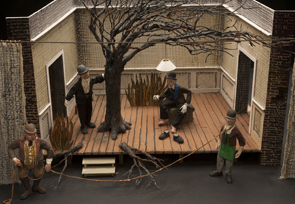Going 'inside' Waiting for Godot: first images of rejected set design released
Release Date 03 August 2015

Previously unseen images of a model stage with a rejected design for one of the first English language performances of Waiting for Godot have been released by the University of Reading.
Renowned for a sparse outdoor setting comprising of an empty stage, a tree, a mound, and five actors, Beckett's Waiting for Godot changed the rules of 20th and 21st century theatre. However this model, made in 1955 by renowned theatre designer Peter Snow, sets Beckett's most famous work indoors.
Material in the University's Beckett Collection reveals Beckett visited Peter Snow's studio and, according to the designer, approved the concept. However, the quite detailed set would have involved additional expense and was never realised. The iconic clumps of reeds and the costumes of the characters based on the actual actors of the 1955 Godot, did make it into the final production, and are beautifully depicted in the model.
Waiting for Godot is one of the most important and best known plays of the 20th and 21st centuries. It opened in Paris in 1953 to mixed reviews, but generated huge interest. The first English language performance at the Arts Theatre in London on August 3rd 1965, directed by Sir Peter Hall, fuelled the controversy surrounding the play.
Professor Anna McMullan, Beckett expert from the University of Reading's School of Film, Theatre and Television, said: "Many critics didn't know what to make of the play. However the influential writer Kenneth Tynan declared himself 'a godotista' and argued that the play breaks all the conventional rules of theatre - no plot, no climax, little information about the characters including one who never appears.
"Central to Godot is the set design - it cleared the stage of furniture and complex plots and reduced the theatre to human beings on stage, interacting with each other. Beckett never intended the play to be set inside. This is part of what makes the beautiful model box so fascinating. Sir Peter Hall and Peter Snow, who designed the set and the costumes, discussed an indoor setting but it didn't happen."
Matthew McFrederick, PhD student at Reading who is working on London productions of Beckett's plays, said: "Material in the Katharine Worth archive at Reading suggests that the model box was made when the play transferred to the larger Criterion Theatre. Snow may also have had in mind making the set more friendly for a West End audience."
"The model box story is a wonderful insight into the working minds of three artistic geniuses," continued Professor Mcmullan. "The development process is rarely straight forward - but their commitment, skill and belief in each other resulted in a performance which transformed theatre production around the world. The play continues to puzzle, entertain, move and intrigue us, as it did the audiences of 60 years ago."
Since the 1950's there have been productions of Waiting for Godot across the globe. The idea of waiting for someone or something that never arrives has spoken to audiences disappointed in a lack of political action, such as Susan Sontag's production of the play during the siege of Sarajevo in 1993, or the post-hurricane Katrina Godot in New Orleans in 2007.
In more recent times, the play's intense focus on the actors has attracted celebrated performers and double acts from Steve Martin and Robin Williams, to Ian McKellen and
Patrick Stewart. In the recent Sydney Theatre Company production which toured to the Barbican Centre, Richard Roxburgh and Hugo Weaving were the leads. This production recalled the indoor design depicted in the model box as it was set in the ruins of a derelict theatre.
The model box was donated to the Beckett Collection by the late Katharine Worth, a renowned scholar of Beckett and of European theatre, in 2013. It can be seen at the University's Special Collections Service on the London Road Campus.
